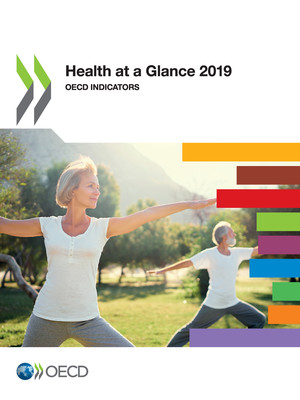copy the linklink copied!Nursing graduates
On average across OECD countries in 2017, there were around 44 new nurse graduates per 100 000 population, with a range from around 14 in the Czech Republic and Mexico to about 100 in Switzerland and Korea (Figure 8.17). This wide range may be explained by differences in the current number and age structure of the nursing workforce, in the capacity of nursing schools to take on more students, and in the future employment prospects of nurses.
Since 2000, the number of nursing graduates has increased in most OECD countries, with the exception of Luxembourg, Japan, the Czech Republic, Lithuania and Ireland. Of these countries, only Japan has maintained a number above the OECD average. In Finland, Hungary and Belgium, the number of nursing graduates has recently returned to numbers above the level in 2000 and is now well above the OECD average, after experiencing intermittent declines.
Despite a more than tenfold increase in the annual number of nursing graduates since 2000 in Poland, Turkey and Mexico, the numbers in these countries remain well below the OECD average. At least 50% increases between 2000 and 2017 are common and are seen across countries with high, medium and low numbers of nurse graduates per capita (Figure 8.18). In total, the number of nurse graduates across OECD countries increased from about 450 000 in 2006 to more than 550 000 in 2017.
The increase in the number of nursing graduates in most casesreflects deliberate policy decisions taken a few years earlier to increase the number of students admitted to nursing schools, in response to concerns about current or possible future shortages (OECD, 2016[1]). In reply to the OECD Health System Characteristics Survey 2016, none of the responding OECD countries reported that they had reduced admission rates for nursing schools and many declared increases (OECD, 2016[2]). Hence, the number of nursing graduates can be expected to continue to increase in most countries in the coming years.
In Norway, the number of students admitted to and graduating from nursing education programmes has grown particularly since 2010, and the number of new nursing graduates in 2017 was one-third higher than in 2000, which should contribute to increasing the supply of nurses. However, as many as one in five recently graduated nurses work outside the health sector. This has led to the implementation of a series of measures in recent years to improve the working conditions of nurses to increase retention rates, including pay raises.
In Italy, the number of nurse graduates increased fairly rapidly in the 2000s but has levelled off and even decreased slightly in recent years. While the number of students admitted to nursing education programmes has remained more or less stable during this decade, there has been a sharp drop in the number of applicants (with the number cut by half), signalling reduced student interest in the profession.
Nursing graduates refer to students who have obtained a recognised qualification required to become a licensed or registered nurse. They include graduates from both higher-level and lower-level nursing programmes. They exclude graduates from Masters or PhD degrees in nursing to avoid double-counting nurses acquiring further qualifications.
The data for the United Kingdom are based on the number of new nurses receiving an authorisation to practise.
References
[1] OECD (2016), Health Workforce Policies in OECD Countries: Right Jobs, Right Skills, Right Places, OECD Health Policy Studies, OECD Publishing, Paris, https://dx.doi.org/10.1787/9789264239517-en.
[2] OECD (2016), OECD Health System Characteristics Survey 2016, http://www.oecd.org/els/health-systems/characteristics.htm.




